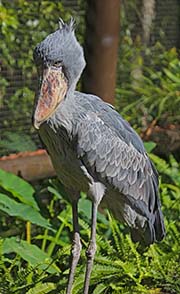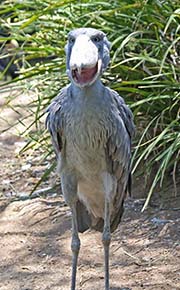Shoebill - Balaeniceps rex
| Length | |
| Wingspan | |
| Weight | |
| Clutch Size | |
| Chicks at birth | |
| IUCN Conservation Status | |
Continents: |
The Shoebill is a huge bird. Another name for them is Whalehead or Shoe-billed Stork. Their name comes from the enormous shoe-shaped bill. The bill is bulbous and hooked at the tip. It is pinkish or yellowish with darker streaks. Shoebills bodies are various shades of gray with a faint greenish gloss. They have a small set of feathers that stick out at the back of their head. Their legs are long and black and their irises are a pale yellow.
They usually fly low but will soars to great height with their legs extended out behind them and their head tucked into their breast.
Juveniles are browner than the adults and the bill is smaller. Chicks are downy, white or silvery gray. The bill is relatively small.
Diet: Shoebills forage for food in shallow waters. When searching for food, they will either move slowly, about one step every 5 seconds, or stand still for long periods with head resting on chest. When prey is spotted they will lunge forward, plunging their whole head and the forepart of body into the water. Prey may be swallowed, regurgitated, bitten several times and swallowed again. Turtles and snakes may be worked for up to 10 min. before being swallowed.
Shoebills eat fish, frogs, mollusk, snakes, young crocodiles, turtles, small mammals, and floating carrion.
Courtship: Shoebills are normally solitary birds. Courtship is the only time when Shoebills are noisy. They will bow to each other, clatter their bills and squeal or whine.
Nesting: Both sexes will build the nest which is made of reeds and other aquatic vegetation that is placed on top of a floating island. The Shoebills either build the floating platform or will use the top of a termite mound that is sticking out of the water. The female usually lays two eggs that are dull white. Nestlings are fed by both parents.
Habitat and Range: Shoebills are found in tropical east African, from Sudan and western Ethiopia to Zambia. They live in large papyrus grass and reed swamps, lakes, and slow flowing rivers.
Vocalization: They are usually silent but will perform bill-clapping and shrill kitelike whistles or whines especially during courtship.
Plumage/Molt Not a lot of information has been published about their molting cycle but it seems to be annual.
Migration: They are not migratory birds but are nomadic.
Tongue/feet: No further information.
Bibliography:
- Maclean, Gordon Linday, Robert's Birds of Southern Africa,John Voelcker Bird Book Fund, 1985
- http://en.wikipedia.org The Free Encyclopedia, Accessed July, 2012
- http://animals.jrank.org Animale Life Resource, Accessed July, 2012
- http://birdlife.org BirdLife International, Accessed July, 2012



